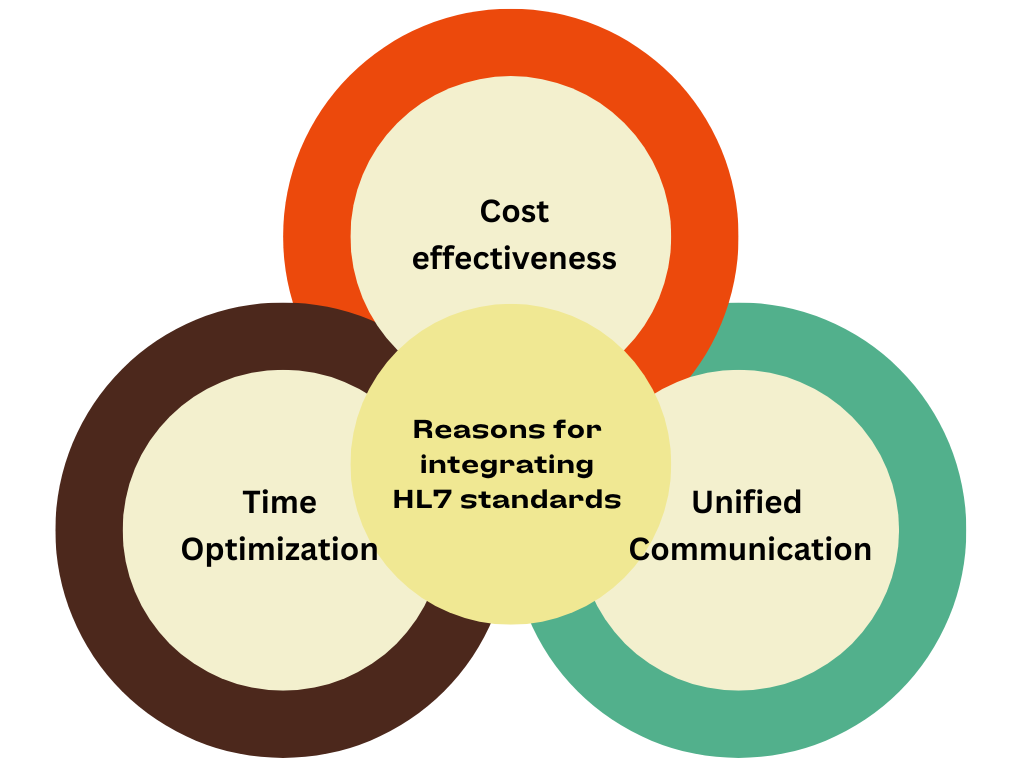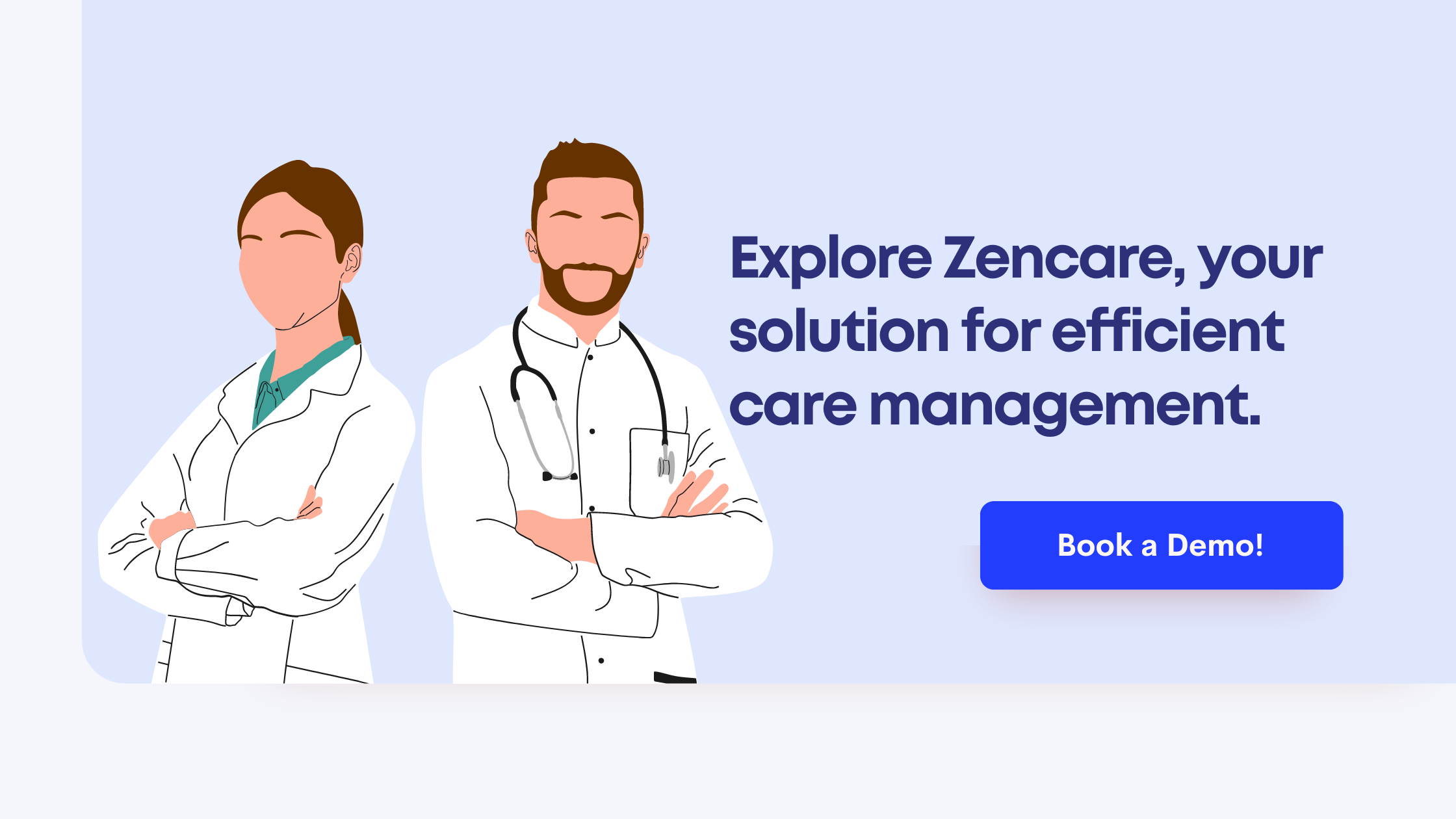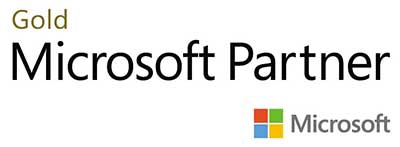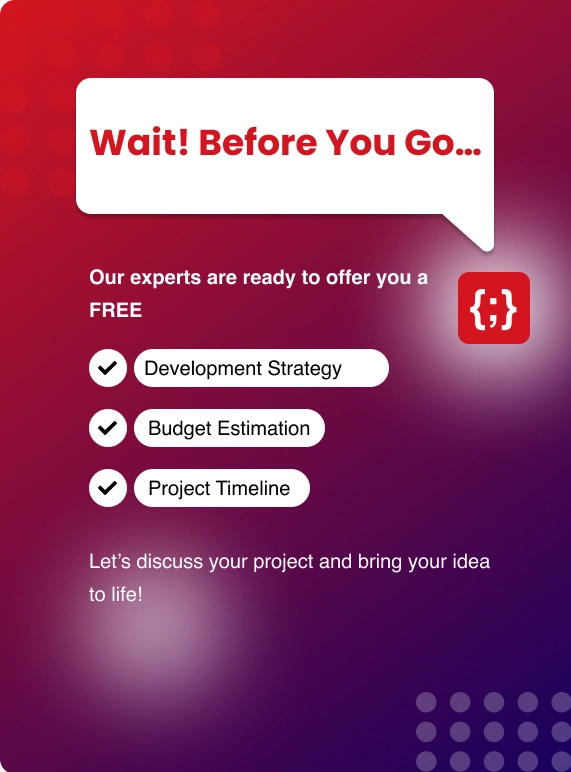Healthcare sectors extremely rely on an array of systems, including laboratory information systems (LIS), EHR, etc. The impact is that it often causes data silos, which are highly independent. The result? It will be challenging to exchange patients' data securely with different healthcare providers.
It might be an urgent buzz for the healthcare industry to look for a standardized communication protocol that ensures quality patient care. The simple healthcare software development solution is HL7 (health level Seven). It not only allows healthcare organizations to seamlessly exchange administrative and clinical data via their computer systems in an easy way, but it also helps them to execute this communication without technical limitations.
Before going further, let's look at some of the statistics that showcase how the integration of HL7 is significant for healthcare organizations.
It might be an urgent buzz for the healthcare industry to look for a standardized communication protocol that ensures quality patient care. The simple healthcare software development solution is HL7 (health level Seven). It not only allows healthcare organizations to seamlessly exchange administrative and clinical data via their computer systems in an easy way, but it also helps them to execute this communication without technical limitations.
Before going further, let's look at some of the statistics that showcase how the integration of HL7 is significant for healthcare organizations.
Healthcare Market Statistics
1. In 2018, the global healthcare analytics market was valued at $11.59 billion, and it is projected to touch the heights of $365.82 billion by the end of 2032.
The Impact: The healthcare industry projection is growing at a CAGR of 28.1%.
2. In 2022, the number of data breaches was 51.9 million, while in 2023, it has an astonishing record of 133 million.
The impact: It shows that there is a significant need to implement a system that can secure data.
The Impact: The healthcare industry projection is growing at a CAGR of 28.1%.
2. In 2022, the number of data breaches was 51.9 million, while in 2023, it has an astonishing record of 133 million.
The impact: It shows that there is a significant need to implement a system that can secure data.
Well, what exactly is Health Level Seven (HL7)?
It is an internationally accepted set of protocols designed by Health Level Seven International. The purpose is to develop a medium that can seamlessly exchange, receive, and retrieve digital information via diverse software applications utilized by health care providers.
Popular HL7 Standards used in the healthcare industry
There are top six HL7 standards that can be used in healthcare software development, such as-
Popular HL7 Standards used in the healthcare industry
There are top six HL7 standards that can be used in healthcare software development, such as-
| Standard | Description | Standard Uses |
| HL7 V2 | This standard comprises 80% of the interface structure, along with interface-by-interface negotiation to cater to 20% of the remaining demands. | It is a type of standard that can be broadly utilized for medical and administrative data such as laboratory results, patient admissions, and more. |
| HL7 V3 | It is a more detailed information model. This standard was introduced into the market in 2005 and was the next HL7 V2 iteration. | It provides more enhanced decision-making when it comes to precise data exchange. |
| HL7 CDA | In this standard, CDA stands for clinical document architecture, which creates and exchanges the most valuable clinical documents in machine-readable format. It incorporates discharge summaries, referral letters, lab results, etc. | It not only provides a seamless information exchange but also ensures patient care coordination and confidentiality of data. |
| EHR | It stands for electronic health record, an HL7 Standard, which consists of the magnitude of profiles along with functional models. | It systematically shares the electronic health data among stakeholders. |
| HL7 CCDA | It is a commonly used HL7 standard, in which CCDA stands for consolidated clinical document architecture. | It does everything— from improvising care coordination to ensuring regulatory conditions compliance to effectively sharing clinical data via the magnitude of HER systems. |
| FHIR | It is a widely new and qualitative HL7 standard, where FHIR stands for fast healthcare interoperability resources. It utilizes web-based APIs and modular components. | Effectively provides real-time and administrative healthcare information. |
Technical Aspect of HL7 Standards
It is an array of tools that help other healthcare technologies and software to communicate with each other using a component (known as an HL7 integration engine).
Why is it used?
It ensures that all the data, whether it's patient information or laboratory results, ensures that all the data should be shared safely and efficiently between labs, hospitals, and clinics.
How HL7 works?
1. HL7 Messages
They are text-based, follow the ASCII format, and consist of various sections known as segments.
Segment? It incorporates specific details— such as who sends the message along with medical results and patient information.
2. Message parts
a) Message Header (MSH)
It includes all the parts of the message, such as
It incorporates all the patient's information, such as
This message part shares the information regarding the diagnosis of the patients.
3. Other standard segments
Why is it used?
It ensures that all the data, whether it's patient information or laboratory results, ensures that all the data should be shared safely and efficiently between labs, hospitals, and clinics.
How HL7 works?
1. HL7 Messages
They are text-based, follow the ASCII format, and consist of various sections known as segments.
Segment? It incorporates specific details— such as who sends the message along with medical results and patient information.
2. Message parts
a) Message Header (MSH)
It includes all the parts of the message, such as
- Who sends the message
- Who is going to receive it
- When it was being sent.
It incorporates all the patient's information, such as
- Name
- Address
- Marital status
- Social security number
This message part shares the information regarding the diagnosis of the patients.
3. Other standard segments
- Event type (EVN)
- Insurance (IN1)
- Guarantor (GT1)
- Next of kin (NK1)
- Observation Request (OBR)
- Observation Result (OBX)
- Financial Transaction (FT1)
- Whatever the segments present in the HL7 message have some sort of specific data fields that act as a communicator between various healthcare systems.
- However, it should be correctly marked with the help of particular symbols so that the receiving system can easily interpret the message.
How helpful is HL7 in the healthcare sector?
HL7 guidelines are created to ensure that all applications seamlessly communicate when it comes to the data exchange process. To put in another way- all the systems talk in the same language."
HL7 is used in healthcare software development products that not only establish seamless communication between hospitals and diverse medical facilities but also exchange very sensitive information in compliance with HIPPA.
It is helpful in following healthcare aspects such as
HL7 is used in healthcare software development products that not only establish seamless communication between hospitals and diverse medical facilities but also exchange very sensitive information in compliance with HIPPA.
It is helpful in following healthcare aspects such as
- Admission of the patients and their discharge notifications to the hospital.
- Information regarding patient transfer to a different room, along with status changes.
- Updates about patients' disease and allergies
- Updates regarding the medical supervisor, such as doctor or nurse.
- Share lab test reports and other master files.
- Provide information regarding patients' medication or special food requirements.
What are the reasons for integrating HL7 standards in healthcare?

Reason 1: Cost-effectiveness
Incorporating the HL7 standards helps reduce the overall healthcare cost by around $30 billion by reducing redundant IT effort.
Reason 2: Unified Communication
From sharing seamless communication to synchronization of all electronic records, HL7 has no match.
Reason 3: Time Optimization
Due to HL7 integrations, developers do not need to build anything from scratch to interconnect two or more healthcare systems, as there are readily available communication rules that are inked by HL7 protocols.
What are the significant benefits of HL7 integration in healthcare?
Utilizing healthcare software development not only helps to refine communication but also helps in the management of hospital’s valuable data. What’s more? It allows healthcare providers to incredibly access critical patient data in real-time to provide top-notch patient care.
Let's focus on the vital benefits of HL7 integration
Benefit 1: Improved Patient Care
HL7 standards help healthcare professionals access patients' data in real-time— improving diagnosis and treatment.
Benefit 2: Enhanced operational efficiency
With the help of HL7 integration, it automates the data exchange, which in turn eliminates manual tasks and minimizes data entry errors, at the same time enhancing productivity.
Benefit 3: Improvise Interoperability
HL7 seamlessly provides the capabilities for data exchange via a variety of healthcare systems. The result? Minimized data silos with enhanced data-sharing capabilities.
Benefit 4: Efficient data analysis
It supports advanced analytics and more precise predictive models to gain detailed health insights— which helps to utilize data efficiently and improve patient outcomes.
Benefit 5: HIPPA compliance
HL7 integration adheres to privacy laws, which can lower the risk of compliance penalties along with building regulators' and patients' trust.
Let's focus on the vital benefits of HL7 integration
Benefit 1: Improved Patient Care
HL7 standards help healthcare professionals access patients' data in real-time— improving diagnosis and treatment.
Benefit 2: Enhanced operational efficiency
With the help of HL7 integration, it automates the data exchange, which in turn eliminates manual tasks and minimizes data entry errors, at the same time enhancing productivity.
Benefit 3: Improvise Interoperability
HL7 seamlessly provides the capabilities for data exchange via a variety of healthcare systems. The result? Minimized data silos with enhanced data-sharing capabilities.
Benefit 4: Efficient data analysis
It supports advanced analytics and more precise predictive models to gain detailed health insights— which helps to utilize data efficiently and improve patient outcomes.
Benefit 5: HIPPA compliance
HL7 integration adheres to privacy laws, which can lower the risk of compliance penalties along with building regulators' and patients' trust.
10 Step process to develop an HL7 interface?
Building an HL7 interface requires a series of steps such as,
Step 1: Define Objectives
It is the first step that involves clearly defining the goals for creating an HL7 interface, such as system-involved data exchange.
Step 2 Select the integration solution.
When choosing an integration solution, it is required to select the right one that is incredibly aligned with the interface engine, middleware, communication, etc.
Step 3: Choosing the HL7 version
The correct version, such as HL7 V3 or HL7 CDA, needs to be chosen according to the healthcare industry's unique requirements.
Step 4: Mapping the data
This step is essential for incorporating the transformation rules, aligning the data fields, and mapping the data between target and source systems.
Step 5: Message generation
After the data mapping, it is essential to curate HL7 messages that adhere exceptionally to the chosen HL7 standard.
Step 6: Rigorous testing
It is very important to perform rigorous testing for troubleshooting to ensure accuracy and guarantee the secure transmission of data.
Step 7: Creating an error-handling mechanism
Whenever potential issues arise in data exchange, it is extremely important to build a robust error-handling mechanism system.
Step 8: Detailed documentation
In this step, detailed documentation needs to be maintained that incorporates error handling procedures, transformation rules, message formats, etc.
Step 9: Compliance
The HL7 interface must follow all compliance standards and regulations to minimize compliance penalties and ensure patience and trust.
Step 10: Staff training
Proper training for the staff is essential to ensuring that the system operates optimally.

Step 1: Define Objectives
It is the first step that involves clearly defining the goals for creating an HL7 interface, such as system-involved data exchange.
Step 2 Select the integration solution.
When choosing an integration solution, it is required to select the right one that is incredibly aligned with the interface engine, middleware, communication, etc.
Step 3: Choosing the HL7 version
The correct version, such as HL7 V3 or HL7 CDA, needs to be chosen according to the healthcare industry's unique requirements.
Step 4: Mapping the data
This step is essential for incorporating the transformation rules, aligning the data fields, and mapping the data between target and source systems.
Step 5: Message generation
After the data mapping, it is essential to curate HL7 messages that adhere exceptionally to the chosen HL7 standard.
Step 6: Rigorous testing
It is very important to perform rigorous testing for troubleshooting to ensure accuracy and guarantee the secure transmission of data.
Step 7: Creating an error-handling mechanism
Whenever potential issues arise in data exchange, it is extremely important to build a robust error-handling mechanism system.
Step 8: Detailed documentation
In this step, detailed documentation needs to be maintained that incorporates error handling procedures, transformation rules, message formats, etc.
Step 9: Compliance
The HL7 interface must follow all compliance standards and regulations to minimize compliance penalties and ensure patience and trust.
Step 10: Staff training
Proper training for the staff is essential to ensuring that the system operates optimally.

Real use cases of HL7 integration in healthcare
1. EHR integration
HL7 integration in healthcare software development allows electronic health record (EHR) integration for performing various functions:
When a test has been done, it can be directly sent to the doctor's system using HL7 messages.
It helps to inform doctors as well as patients regarding their upcoming visits by sending them appointment updates or reminders.
2. Pharmacy systems integration
This type of integration provides exceptional communication between pharmacies and hospitals. For instance, if a doctor prescribes any medication, it will be automatically sent to the pharmacy department utilizing Hl7 messaging. The result will be that pharmacies ensure medication availability and eliminate manual entry.
3. Clinical decision support systems (CDSS)
It can effectively help healthcare providers by giving them with real-time recommendations by incredibly analyzing patient data. For example, a CDSS effectively analyses the patient's medication lab results and history. Based on that, it suggests treatment plans, drug interactions, diagnosis suggestions, and more.
Other real use cases of HL7 integration are
HL7 integration in healthcare software development allows electronic health record (EHR) integration for performing various functions:
When a test has been done, it can be directly sent to the doctor's system using HL7 messages.
It helps to inform doctors as well as patients regarding their upcoming visits by sending them appointment updates or reminders.
2. Pharmacy systems integration
This type of integration provides exceptional communication between pharmacies and hospitals. For instance, if a doctor prescribes any medication, it will be automatically sent to the pharmacy department utilizing Hl7 messaging. The result will be that pharmacies ensure medication availability and eliminate manual entry.
3. Clinical decision support systems (CDSS)
It can effectively help healthcare providers by giving them with real-time recommendations by incredibly analyzing patient data. For example, a CDSS effectively analyses the patient's medication lab results and history. Based on that, it suggests treatment plans, drug interactions, diagnosis suggestions, and more.
Other real use cases of HL7 integration are
- Laboratory information systems (LIS) communication
- Telehealth services
- Patient scheduling systems and more.
Conclusion: why choose Zenesys for your next project?
Integration of HL7 in the healthcare sector enables them to boost their operation and achieve interoperability along with enhancing the patients care.
Do you want to incorporate HL7 integration into your healthcare app? Zenesys, a Healthcare software development company, uses the full capabilities of HL7 standards to ensure unparalleled integration solutions.
Explore Our Work: How We Enhanced Information Security for Medical Center with HIPAA-Compliant SaaS Solutions
Do you want to incorporate HL7 integration into your healthcare app? Zenesys, a Healthcare software development company, uses the full capabilities of HL7 standards to ensure unparalleled integration solutions.
Explore Our Work: How We Enhanced Information Security for Medical Center with HIPAA-Compliant SaaS Solutions
FAQs
1. What are the common challenges that come during the time of the HL7 integration project?
Complexity and variability in HL7 standards— require detailed customization and mapping, which takes a significant amount of time. Interoperability via different HL7 versions, which requires technical expertise along with dedicated resources.
2. Which organizations require an HL7 integration search engine?
Many healthcare organizations require seamless HL7 integration in healthcare software development, such as-
3. Does Zenesys offer HL7 integration services?
Yes, we offer HL7 integration services— from simple to complex medical app projects. We are delighted to provide you a handholding support for your healthcare project. If you have any concerns or doubts, you can always connect with our team!
Complexity and variability in HL7 standards— require detailed customization and mapping, which takes a significant amount of time. Interoperability via different HL7 versions, which requires technical expertise along with dedicated resources.
2. Which organizations require an HL7 integration search engine?
Many healthcare organizations require seamless HL7 integration in healthcare software development, such as-
- Hospitals
- Clinics
- Medical centers
- Healthcare process stakeholders.
3. Does Zenesys offer HL7 integration services?
Yes, we offer HL7 integration services— from simple to complex medical app projects. We are delighted to provide you a handholding support for your healthcare project. If you have any concerns or doubts, you can always connect with our team!


.webp?lang=en-US&ext=.webp)

.webp?lang=en-US&ext=.webp)

